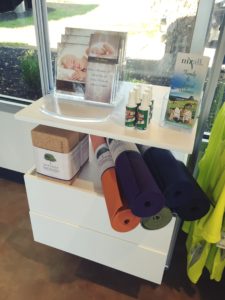

Maybe you heard, September was National Yoga Month. New students have been showing an interest, rushing to sign up for the variety of community classes available. More consumers are also surveying retail shops for yoga accessories to ensure they are properly equipped.
“As clients step into the world of yoga, they often are intimidated,” says yoga instructor RyeChelle Canady who works at the Grant Beach Hovey House Center. “They are unsure of what to bring, what to wear and how to go beyond their own skill set. This is typically true for beginners.”
The Scoop talked with Canady along with two managers from the Dynamic Body studio and one other local yoga instructor to get their insight on accessory options for aspiring yogis. The experts provided seven suggestions for looking the part and increasing overall performance on the mat.
1. Straps
“I usually use straps with my elderly students, who can’t really kick their legs up,” Canady said. “Instead, they can stand by the wall and lift their leg up with the strap. If you have trouble with balance, you can still get into your pose.”
According to Canady, straps test one’s flexibility from week to week, so students can monitor their physical fitness throughout the class. The goal is to eventually leave behind the aids when you are “at the peak of your practice,” but start out with them for ease when the body is more vulnerable to injury.
Other studios blend straps into their daily workouts. Boutique manager Kari Touhey at Dynamic Body noted that participants can suspend themselves from secure ropes around their legs and waists in a Rope Yoga class.
“We have a yoga wall available, and you can hang the straps from the wall,” Touhey said. “They simply hook in for extended routines.”
These ropes allow for trouble-free inversions from pose to pose, and they are useful when students need to hold a stretch for greater lengths of time.
2. Bolsters and Blocks
For meditation purposes and restorative yoga, Dynamic Body studio manager Erin Hession suggested that alignment of the spine when sitting is important. Each person has unique needs, but instructors can decide where blocks or bolsters should be positioned for maximum support when they witness someone struggling.
“If you aren’t able to get all the way to the floor in a pose, you can use the blocks and bolsters to stabilize, so it gives you an extra six inches,” Hession said. “They also use them to prop ankles, knees and the neck for comfort in a particular pose.”
Blocks are offered in a variety of materials like foam and cork, depending on the user’s preference. Bolsters are similar to cylindrical pillows, which are made of synthetic fibers or biodegradable, organic cotton.
3. Yoga Mat

Canady stressed that students should purchase a yoga mat that is cushioned enough to withstand daily use. This extra padding will guarantee that the body’s weight avoids any abrupt impact when hitting the floor. Thin mats are often economical, but they wear out quickly from movement and are not ideal for long-term use.
“It is the person’s choice,” Canady said. “I started with a cheap ten-dollar mat because that is what I could afford. When I started meditation, going to yoga festivals and doing yoga all day, I needed a thicker mat.”
Many mats sold today contain toxic chemicals. Touhey suggested locating a PVC-free mat without vinyl, and buying brands that support worthy causes.
“Our products are natural,” Touhey said. “We carry Jade yoga mats. For every mat that they sell, they plant a tree.”
4. Clothing
Apparel selections vary based on school. Yin Yoga, for example, is a cooling practice that requires layers to ensure that blood circulates. Hot Yoga studios however, request that participants wear breathable articles of clothing, so the rising temperatures do not overheat the body, and they can easily sweat it out.
“A lot of people just wear little yoga shorts and tank tops, but there are also people that wear yoga pants because you get sweaty and it’s hard to get a grip,” Canady said.
Though some businesses prefer everyone to be barefoot, others have hygienic guidelines to keep their floors clean. Dynamic Body insists students bring specially designed socks. These rules also prevent unnecessary falls.
“ToeSox have grippers on the bottom, so they can use those in their classes for balance,” Touhey said. “It’s a different option, rather than tennis shoes, to prevent the room from getting dirty.”
5. Water Bottle
Although trendy clothing and innovative props are useful, they are not required for a basic practice. Nevertheless, preventing dehydration is a priority. Experienced yogis, like Christine Rogers at Circle on the Square, recommend carrying water with added electrolytes at all times. Students should increase their intake days before the class, rather than waiting until it is over, which may have health consequences.
“I highly recommend drinking water before, during and after class, said Rogers. Yoga releases a lot of toxins. Dizziness may occur if toxins are not flushed out with water. I would rather a student not be dizzy or nauseated.”
6. Foam Rollers
Bikram Yoga has tools to relieve tense, knotted muscles in the neck or back. Students can apply self-myofascial release with foam rollers, which helps promote relaxation, repair past injuries and encourage physical recovery. According to Canady, these rollers target pressure points and roll the body forward, past its usual limitations.
“You just sit on a foam roller, and it loosens up everything, giving you a massage at the same time,” Canady said. “This means on your next pose you can go a little deeper and stretch more.”
7. Blankets
When bolsters and blocks are unavailable, instructors often adjust twin-size blankets as makeshift props. Thermal or woven blankets also assist in Shavasana, known as corpse pose. This closing routine focuses on unwinding muscles, so that they can reset after activity. At some studios, students listen to music selections or experience the reverberation of a gong, while concentrating on their breathing.
“At the end of your practice where you’re relaxing, people cover up with blankets,” Canady said. “In sound healing with gongs and bowls, people leave their feet out to feel the vibrations.”